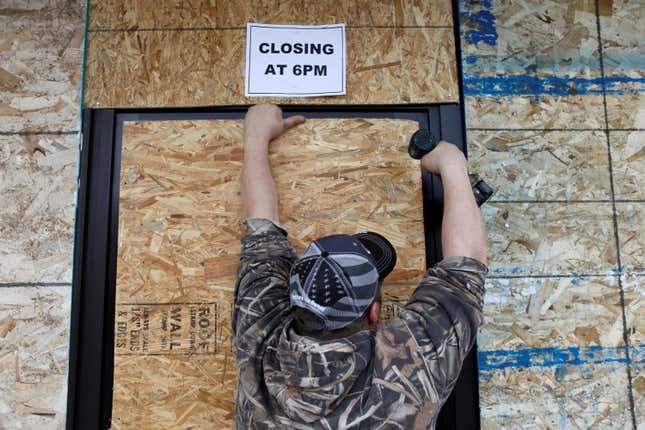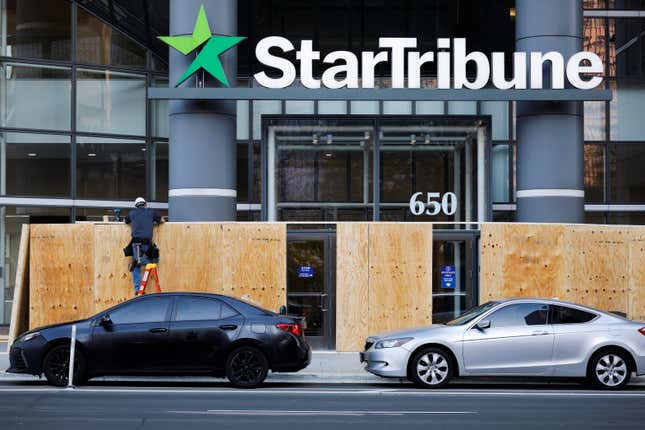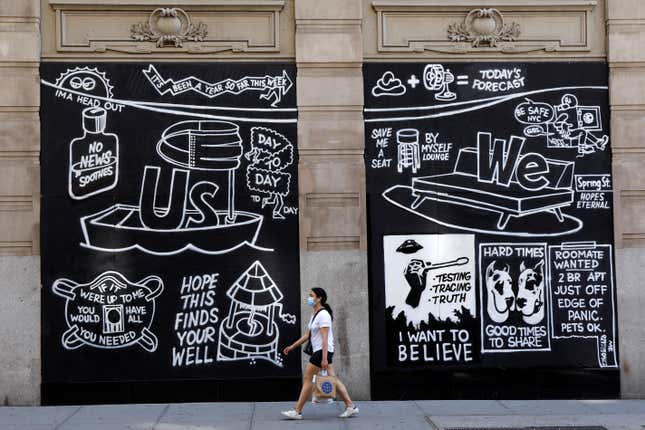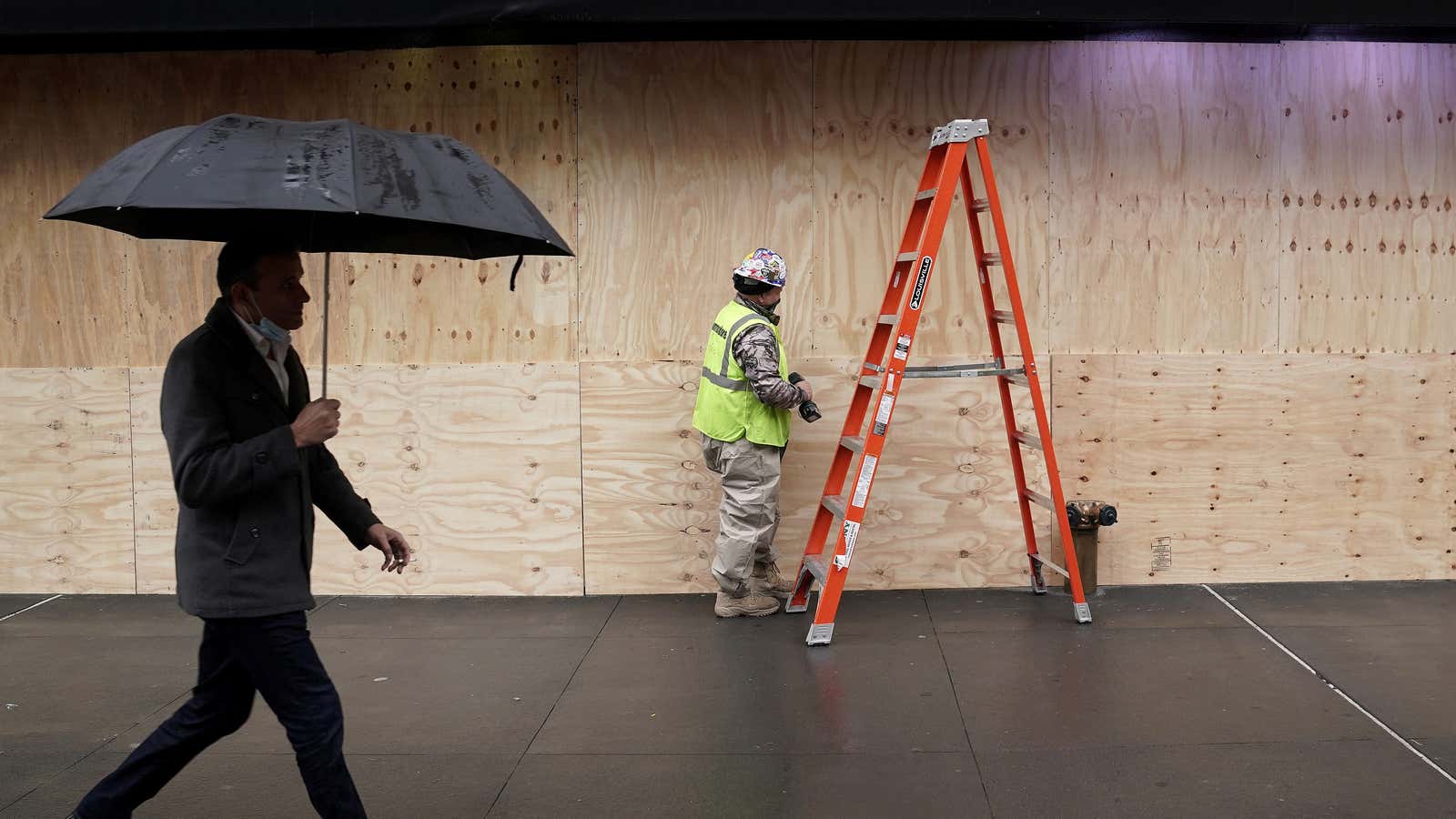We’ve seen this twisted ritual too many times recently.
Restaurants, bars, and shops across the US once again boarded up their windows and doors, bracing for mass upheavals following the trial of Derek Chauvin. As the former Minneapolis police officer was convicted on all charges for the murder of George Floyd last night, many establishments kept their plywood shields in place, anticipating street celebrations and demonstrations this week. More than a nuisance, seeing storefronts poised for violence has a profound effect on our mental health and social relations.
Learning from the widespread looting and vandalism that occurred in June, as protests over Floyd’s murder came to a boiling point, businesses have been preemptively covering their façades. In New York City, San Francisco, Philadelphia, and Chicago—hundreds of miles from Minneapolis courtroom where the trial was held—establishments erected the now all-too-familiar plywood shields to protect their property. Stores who managed to survive the economic downturn also boarded up during the US presidential elections in November and every high-profile instance of police brutality since then. Emergency board-up assistance is a thriving line of business, a service that was once mostly prevalent in coastal states prone to flooding and hurricanes. Luxury stores are barricaded in branded coverings and even several Apple Store outlets—once bastions of soaring glass architecture—have resorted to hiding behind boards. It’s a grim trend that resulted in a plywood shortage last year.
The trauma of blank façades
How does seeing these urban shields affect us? Apart from the added expense for struggling business owners—around $3,000 to $10,000 according to one estimate—researchers say that seeing blank facades has a deeper, more lasting effects on our quality of life.
“Blank building façades are correlated with low levels of happiness,” says Charles Montgomery, founding principal of Happy City, a Vancouver-based urban planning and design consultancy. Citing research in New York City and Seattle, he explains that a vibrant streetscape teeming with the thrum of commercial activity has been found to slow people down, encouraging them to engage with their surroundings and their neighbors. “There’s a strong correlation between velocity, or how fast we move, and how we feel about a place and how we feel about each other,” says Montgomery, who wrote a book on the subject.
The sight of plywood veneers puts everyone on guard. “The most powerful ingredient for human well being is trust and we’re in a historic moment of low trust in the United States,” says Montgomery. “There are many reasons for this trust crisis, but design is one of them—the landscapes we design and inhabit influence how we feel and how we feel about other people. Our buildings are speaking to us all the time even if we don’t realize it or you may not.”
In boarded-up streets, pedestrians tend to become more insular. “Blank edges are like broken teeth,” he explains. “In our studies, we found that people are less likely to keep walking along streets edges when when those edges are blank, when buildings are missing, or when buildings are boarded up. We’re seeing formerly active social landscapes transformed into dead spaces. These are really unhealthy for us.”


Montgomery’s research tracks with previous studies about boarded up properties in economically depressed neighborhoods. A 2013 article in the Journal of Urban Health states:
A study of 107 US cities showed boarded-up housing to be associated with poor health, including outcomes as divergent as gonorrhea rates, pre-mature mortality, diabetes, and suicide, even after controlling for confounding by sociodemographic factors. The presence of vacant homes has also been associated with higher levels of crime and illegal activity such as prostitution, drug sales, and drug use by adolescents. Vacant land has also been linked to elevated risk of fire injury.
The correlation between mental health and street life is even reflected in the planning of Disneyland, which embraces the tagline “happiest place on earth,” Montgomery adds. “Main Street USA never features more than three or four feet of blank space,” he notes, referring to a main thoroughfare in the theme park. “Every inch of the sidewalk features something to generate curiosity and wonder. They even use scent like the smell of fudge wafting into the streets.”
Healing through street art
This however doesn’t mean that we have to transform neighborhoods into cacophonous commercial hubs. “We’re often happiest somewhere in the middle,” Montgomery clarifies. “We’re happiest in environments where there’s evidence of social activity, commerce, and surprise… combined with access to nature.”
Hiring artists to paint on the plywood boards will help bring back a vestige of local character and liveliness, Montgomery suggests. Indeed, storefront boards have become canvasses for both love and angst—art and graffiti—throughout the succession of social upheavals during the pandemic.

In Minneapolis, a non-profit called Memorialize the Movement has been saving painted boards in the hopes of starting a gallery one day. “Once you look at the entire story, you see this is an entire city’s grief,” Leesa Kelly, the organization’s founder said in an interview with the local news channel Denver 7.”We’ve done something here that hasn’t been done before. We’ve recorded our own history, Black and brown history.”
But even Kelly sounded overwhelmed upon learning that more boards are going up for Chauvin’s trial. Gesturing to the stacks of painted plywood boards behind her, she said,”Now seeing them up again, it feels really hopeless because this is 10 months worth of hard work—literal back-breaking work.”
